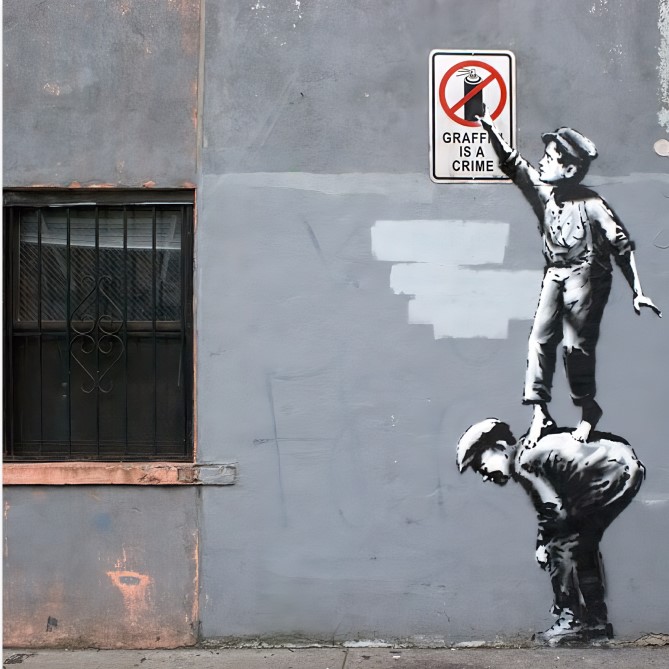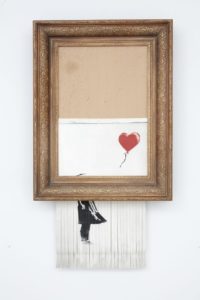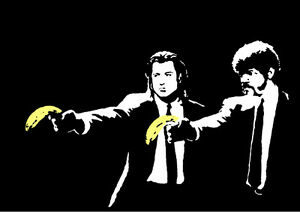
The spotlights focus. The curtain draws. The gavel strikes for the third time. And sold.
On 5th October 2018, right after the closing bid, UK’s favourite artwork (according to a Samsung poll in 2017), ‘Girl with Balloon’, began to self-destruct. However, it stopped midway, giving us probably the most significant piece of live art in the past decade. This is when Banksy became a familiar name around the world despite being named one of Time’s 100 most influential people in 2010. But this wasn’t the first time that his antics had shown his disgust for the traditions existing in the art world.

The artist, whose identity remains largely unknown, is believed to have entered the graffiti scene in the late 1990s. Arguably the most controversial street artist in the world, his work was more prominent after he moved to London in the early 2000s. A small rat— the mark of Blek Le Rat— has been illustrated in many of Banksy’s initial artworks. It was also around this time that Banksy turned to stencil work after he was almost caught by authorities once when he was around 18.
In 2003, Banksy painted over animals for an exhibition called Turf Wars. While RSPCA (Royal Society for the Prevention of Cruelty to Animals) declared the conditions suitable, animal rights activists were displeased about it and caused controversy. Banksy gave one of his first-ever interviews after the exhibition. Little did Nigel Wrench, BBC reporter who interviewed Banksy, know back then that Banksy would turn out to be such a global icon. But the BBC issued a statement, not long ago, asking the public to believe at their own risk if it was indeed Banksy, thanks to the nature of the artist.
This wasn’t the only time Banksy ran into trouble with animal rights activists. In 2006, at his exhibition called Barely Legal, the artist featured a live ‘Elephant in the Room’ painted in a manner that drew the visitor’s attention to the world of poverty. Even though a valid permit was obtained for the animal, the stunt did not sail well with activists. The exhibition also featured a painting of Queen Victoria as a lesbian.
During the 2000s, a notable ‘prank’ of his was detected, in which he replaced the Queen’s head with that of Princess Diana in the 10-pound notes. He also replaced the text from Bank of England to Banksy of England. While the British Royalty were displeased, they weren’t the only ones who disliked Banksy.
An artist called King Robbo, one of the more prominent Graffiti artists of London was not left behind. Banksy started a feud with him by painting over one of Robbo’s famous pieces in London, in 2009. The feud lasted for over 6 years with both artists going back and forth and only came to an end in 2011 when Robbo went into a coma after a head injury. Robbo later died in 2014. Banksy showed his respect for the artist by recreating the painting he destroyed in the first place in his own style.
In 2015, Banksy gave the world his own sinister twist on Disneyland through his project, Dismaland – Bemusement Park. It was a three day themed park which Banksy called a “family theme park unsuitable for children.” The installations were later used to raise money for Help Refugees, a non-governmental organization.
Banksy’s artwork is just the artist voicing his opinion on various issues such as Refugee crises, the way the art world works, global warming, and Brexit. It is ironic though, how despite all these successful pieces of art, the artist became famous worldwide for something he failed. The ‘Girl With Balloon’ artwork, which was shredded halfway, was not supposed to have stopped. The artist later released a video, explaining the contraption of the frame. “In rehearsals, it worked every time,” the masked person said, despair showing in his tone.
What is the Banksy effect?
Banksy, despite all his controversies, has had a huge impact on street art. Not only did he help bring it to the limelight but also he has changed the view of graffiti forever. His work has always been politically charged, giving the art style of graffiti a new face, changing its general perception from that of a nuisance to somewhat impactful. A newfound interest in the graffiti style started to develop amongst the general population. This effect was coined as ‘the Banksy effect” by CNN correspondent, Max Foster.
He once told Tristan Manco, an author, and his friend “As soon as I cut my first stencil I could feel the power there. I also like the political edge. All graffiti is low-level dissent, but stencils have an extra history. They’ve been used to start revolutions and to stop wars.”
However, despite the ever-growing position of street art as a recognised and popular art form, it is still widely considered illegal. Banksy’s work may have an impact and his fame may spread far and wide, but even he has to fight for the existence of his work. Several of his artworks such as “Pulp Fiction”, showing the main characters of the pop culture classic Quentin Tarantino movie holding bananas instead of guns.

Most of Banksy’s work also depends on the element of surprise- his artwork is random and appears all of a sudden with no previous indication of it. Since his art is always so sudden, there is no anticipation for it at all, which in turn affects the impact of his art.
Banksy’s contribution to the street art style, cannot promise the immortalisation of his work. While his art continues to have an impact in the current world, there is no telling if his work will last in the memory of the world forever.
Is His Art Imitation?
In today’s world, where media is either a hybrid or replica of what has already been, what makes us so sure that artists don’t do it either? Media is collected from different eras and blended together to make something new while paying homage to the original. As time progresses, the line between derivative and plagiarism is starting to become more and more blurry, questing if inspiration and imitation truly do not have much difference.
Banksy began his graffiti lifestyle by admiring the work of great artists like Blek Le Rat and Andy Warhol. In fact, he often recycled their old ideas. In 2006, Banksy sold a painting of Kate Moss, painted in a manner similar to the painting of Marilyn Monroe made by Andy Warhol. So how is it that such a big artist has gotten away with something like this? Is it really plagiarism or just inspiration?
“Good artists copy, great artists steal.” This saying by Pablo Picasso has inspired many artists, thinkers, and students who are guilty of copying. Ironically enough, it inspired Banksy as well. For a piece of his, Banksy carved the quote in stone and crossed out Picasso’s name, before carving in his own.
Over the period of human evolution, we have seen art in many different forms. Whether it be from nature, humans, or things we have made. And although we evolve, art doesn’t. Art has always been about making humans feel something. So while art cannot evolve by itself, our perception of it makes us believe that it does.

Relating this to the conversation of plagiarism, it broadens our understanding of how the most creative innovations are often just new combinations of old ideas. It is almost impossible to think of something which hasn’t already been done before if you think about the ideas that have been presented by people.
Conclusion
Most people require an entry point to become comfortable with new things, and Banksy is that entry point for millions of people. His art influences us so much that they provoke debates about war, politics, social media, and many more topics. His work inspires many and after all, isn’t that what art is supposed to do? Inspire us and make us want to make things ourselves?
Written by Tanya Jain, Kaavya Azad and Praneeth Ratnagiri for MTTN
Featured Image: ‘The street is in play’ by Banksy
Leave a Reply
You must be logged in to post a comment.